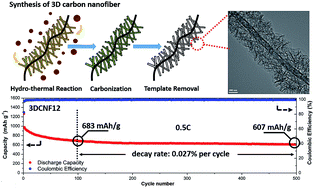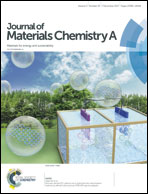One-step synthesis of carbon nanosheet-decorated carbon nanofibers as a 3D interconnected porous carbon scaffold for lithium–sulfur batteries†
Abstract
Among the emerging energy storage methods, lithium–sulfur (LIS) batteries have drawn plenty of attention due to their high theoretical energy density, low cost and environmental benignity. Nevertheless, the insulating nature of sulfur and notorious polysulfide shuttling result in low sulfur utilization and short cycling life. In recent years, various carbon structures have been reported as effective sulfur hosts to tolerate volume expansion, prevent polysulfide dissolution and enhance electrical conductivity. It is hard for carbon materials, however, to satisfy all these aspects with a simple structural design. Thus, developing hierarchical carbon structures that serve as a multi-functional host is necessary for high-performance LIS batteries. Herein, we reported a facile method to prepare a three-dimensional carbon nanofiber (3DCNF) through a hydrothermal reaction. With the structural advantages, the 3DCNF and sulfur composite delivered a capacity as high as 1266 and 977 mA h g−1 at 0.1 and 0.5 C, respectively. After 500 cycles at 0.5 C, it still retains a capacity of 607 mA h g−1 (0.07% capacity fading per cycle), exhibiting excellent cycling capability.



 Please wait while we load your content...
Please wait while we load your content...